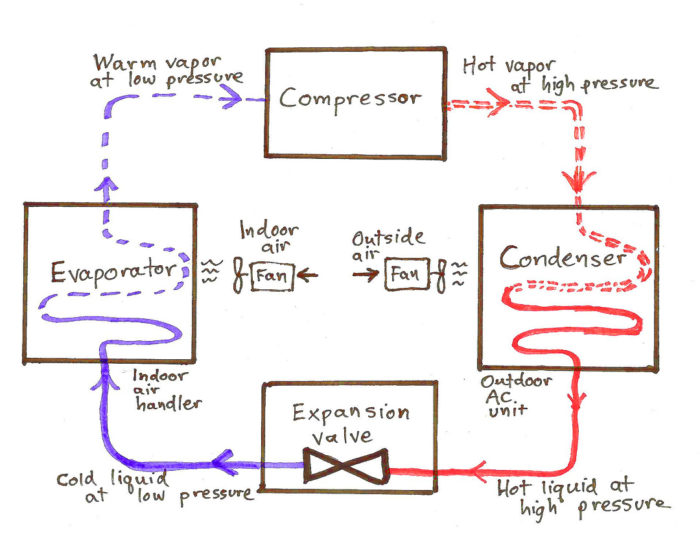
Image Credit: Martin Holladay
What does a Vermonter know about air conditioning? I live so close to the Canadian border that half of the radio stations are in French. If my house needs cooling, I just let the fire in the wood stove die down.
When I first began reporting on air conditioning topics over a decade ago, I felt out of my element. Impelled by the certainty that there’s no such thing as a dumb question, I’ve managed over the years to badger a few air-conditioner experts, all of whom contributed to my education. So now I finally know the difference between an evaporator coil and a condenser coil.
In no particular order, here are the answers to a few air-conditioning questions.
Divorce decree
Q. What’s a “split” air conditioner?
A. A split air conditioner is the typical central air conditioner found in many U.S. homes. It consists of an outdoor unit that sits on a small concrete pad and an indoor coil located in the furnace plenum or the air handler. The term “split air conditioner” distinguishes this type of cooling system from other types of air conditioners, including window units.
Two thousand pounds of … I dunno
Q. What’s a ton of cooling?
A. In the old days, people used to buy ice to keep cool. A “ton” of cooling capacity is based on the amount of heat absorbed by one ton of ice melting over 24 hours. One ton of cooling capacity is equal to 12,000 Btu/h.
Maybe “Dental X-Rays”?
Q. What does “DX” stand for?
A. DX stands for Direct eXpansion — the standard refrigeration cycle used in most American air conditioners. (There are other refrigeration cycles — for example, the ammonia absorption cycle used in propane-fueled refrigerators.)
Calculating efficiency
Q. What’s a SEER rating?
A. SEER…
Weekly Newsletter
Get building science and energy efficiency advice, plus special offers, in your inbox.

This article is only available to GBA Prime Members
Sign up for a free trial and get instant access to this article as well as GBA’s complete library of premium articles and construction details.
Start Free TrialAlready a member? Log in





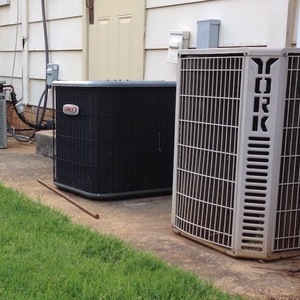
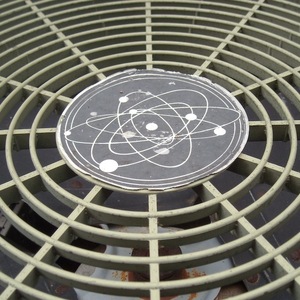
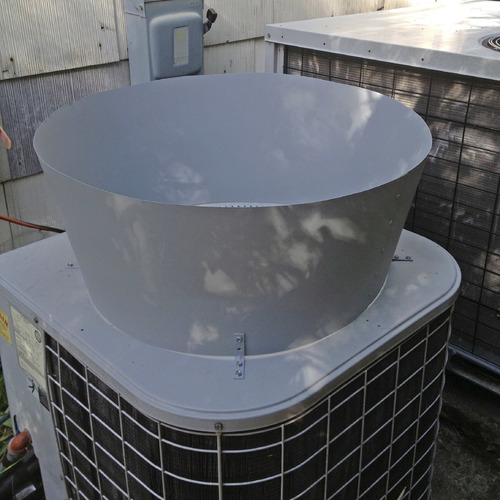
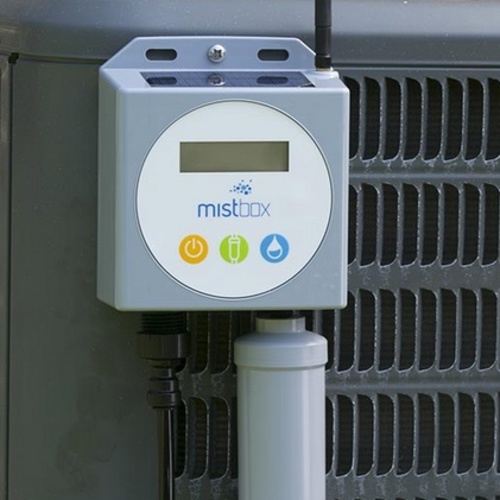






10 Comments
How about mini-splits & high-velocity systems?
Martin,
Can you expand your explanation to mini-split heat pumps and high-velocity mini-duct systems?
Thanks
High velocity
High velocity systems seemed to be the rage about 5 years ago when I attended the 4B Conference in Green Bay, not heard much about them since.
Minisplits and high-velocity systems
Michael,
I'm not sure what you need to know, but here are a few thoughts:
1. High-velocity air conditioning systems have few benefits except for the fact they they use ducts with a small diameter. Such small diameter ducts are useful in retrofit situations. But these air conditioners are less efficient than other options, so they are best avoided unless you need to snake ducts in tight quarters.
For more information on high-velocity systems, see
https://www.greenbuildingadvisor.com/green-basics/air-conditioning
2. Ductless minisplit air conditioners are the standard air conditioner in Asia and Europe. In the US, they cost more than standard split-system air conditioners; since Americans aren't used to seeing the wall-mounted fan-coil units indoors, most Americans prefer the systems they are used to.
People who can afford ductless minisplits (and who don't mind the appearance of the wall-mounted indoor units) are usually delighted with their performance.
Some ductless minisplits are used for cooling only; others are reversible heat pumps than can provide both heating and cooling. In recent years, Japanese and Korean manufacturers have come out with very efficient ductless minisplits capable of providing space heating at cold temperatures -- even -17°F. They are beginning to be used for all-electric homes in Vermont, and are especially appropriate for Passivhaus buildings or net-zero-energy homes equipped with PV.
For more information on heating with a ductless minisplit, see "Heating a Tight, Well-Insulated House."
Refrigeration cycle
Martin, your refrigeration cycle diagram is correct, but in your explanation of the cycle you have the compressor moving the liquid refrigerant. The compressor sucks in somewhat warmed but vaporized refrigerant from the evaporator coil and pumps it up to some high pressure. That compression makes the vapor hot, so that heat can flow out of it to air moving past the condenser coil.
As an experiment, have someone work the handle of a tire pump like mad, with the hose connected to a tire, and feel how warm the bottom of the pump gets just above where the hose comes out. That heat doesn't come from friction of the piston in the cylinder. The heat represents part of the mechanical energy expended on the gas by the compressor (eg. the guy pumping like mad). The temperature rise can be calculated readily from the properties of the vapor and the compression ratio.
When the warm, high pressure liquid refrigerant crosses the expansion valve, it undergoes what's called a "constant enthalpy" flash, meaning no heat is added or removed (there). Since the low pressure in the evaporator coil is below the pressure that would be needed to keep the refrigerant in a liquid state, some vaporization occurs. Since vaporization requires energy (the vapor refrigerant has a higher heat content than does the liquid form at the same temperature), the temperature of the resulting vapor/liquid mixture must drop, to keep the total heat content of the mixture constant. This is "autorefrigeration." The fluid actually entering the evaporator coils already is partially vaporized (you did say it is a mist). As more heat is added by the air moving past the evaporator coil, vaporization continues to completion, after which the vapor just gets warmer.
The efficiency of the unit, determined in part by the surface area of the evaporator coil, affects the temperature of the vaporized refrigerant leaving the coil and entering the compressor. That temperature is "warm" only in the relative sense, and can't be any warmer than that of the air moving past the evaporator coil.
All refrigeration cycles are "heat pumps," absorbing heat from some low temperature and rejecting it at some higher temperature. Proper selection of fluid to use as refrigerant depends on those "low" and "high" temperatures, whatever they may be. In natural gas processing, to take an extreme example, ethylene can be used as a refrigerant to suck heat out of liquid methane at -260 F, and reject the heat to the evaporator side of a second refrigeration loop, using propylene refrigerant vaporizing at a relatively balmy -50 F. The propylene loop rejects heat to cooling water.
Thanks for fleshing out the explanation
Dick,
Thanks for your in-depth explanation of the refrigeration cycle. I have corrected the text by removing the word "liquid" in the sentence that discussed the compressor.
Lower limit for ethylene as refrigerant
I need to make a correction of my own. I had a different separation in mind when I said ethylene could be used as a refrigerant to suck heat out of liquid methane at -260 F. Actually, the lowest heat source temperature for realistic use of ethylene would be about -150 F, to keep the ethylene vapor to the suction side of the compressor above atmospheric pressure. If you go vacuum, slight air leakage into the system over time runs the risk of an explosive mixture.
ductless mini-splits and their kin
I took a pretty detailed look at mini-splits in this article from Environmental Building News, which people might be interested in checking out:
Ductless Mini-Splits and Their Kin: The Revolution in Variable-Refrigerant-Flow Air Conditioning
Great article, Martin—I love the sense of humor.
– Tristan Roberts
Editor, LEEDuser
http://www.LEEDuser.com
air conditioner
how to clean a/c in my room?
Response to Anny
Anny,
I assume you are asking about a window air conditioner. Here's an article to explain how to clean the filter and indoor evaporator coil of a window-mounted air conditioner:
http://srmi.biz/Tips.Residential_A_C.Cleaning_room_AC.htm
split a/c suction side high pressor
split ac suction side slowley incressing high pressor and h.p switch getting cut off. I have changed new compressor also. but it same.suction charged pressor is 65 psi.
Log in or become a member to post a comment.
Sign up Log in